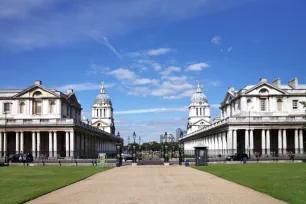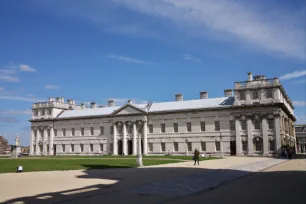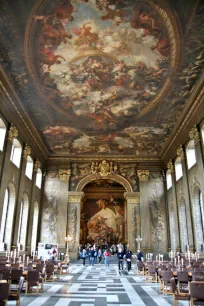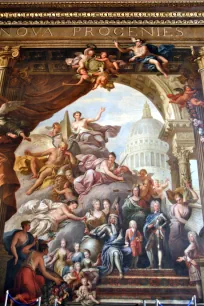The Old Royal Naval College was built at the end of the seventeenth century as a hospital for seamen of the Royal Navy. The hospital’s chapel and dining hall show the grandeur of a bygone era.
Greenwich Palace

King Charles II spent more than eight years in exile in France. When he returned to England after the restoration of the monarchy in 1660 he had ambitious plans to replace the derelict Palace of Placentia in Greenwich with a new palace as grand as the one he had seen in Versailles. The location along the River Thames seemed ideal. Construction started in 1664 after a design by architect John Webb, but after spending a fortune on the first of three planned buildings, the king realized he couldn’t afford such a palace and abandoned his plans.
Greenwich Hospital



Thirty years later Queen Mary II, who preferred to live in Hampton Court, decided to use the existing building as a Royal Hospital for Seamen, similar to the 1691 Royal Hospital for Soldiers in Chelsea. In 1695 the queen asked the architects of the hospital, the esteemed Christopher Wren and his assistant Nicholas Hawksmoor, to come up with a plan for a similar, albeit grander, complex in Greenwich.
Wren’s first proposal was rejected by the queen since it would block the view of the river from the Queen’s House. His revised plan is the one we now see. It consists of four separate buildings that form a quadrant with an axis pointing towards the Queen’s House. Wren mirrored Webb’s building along the river and, behind, created two large domed buildings, each a mirror of the other. The hospital was completed in phases by different architects, all following Wren’s plans. The chapel was finished last, in 1751.
After the hospital closed in 1869 it became the Royal Naval College, a training center for naval personnel. Today the buildings are used by the University of Greenwich and the Trinity College of Music, but the site is still called the Old Royal Naval College.
Painted Hall and Chapel
The buildings of the Old Royal Naval College are not open to the public, except for the Painted Hall and the Chapel of St. Peter and St. Paul, two absolute must-sees for any visitor to Greenwich.
The chapel and hall are situated opposite each other, right below the two domes.


The Painted Hall
The Painted Hall was designed by Wren as the dining room for the seamen. The hall is considered England’s most magnificent dining hall. The room was rarely used for its intended purpose; the Baroque interior is so opulent that it was considered too grand for the seamen. Instead, it became one of London’s first tourist attractions.
The reason why the hall is called Painted Hall becomes clear as soon as one enters the room: covering the ceiling is a huge painting, 15 meters wide and 32 meters long, the largest in the country. It was created by the English painter James Thornhill who spent nineteen years on this masterwork. It is an allegorical representation of the triumph of Peace and Liberty (represented by King William and Queen Mary) over Evil (represented by the French King Louis XIV).
A grand arch, created by Hawksmoor, leads to the upper hall, painted on all sides by Thornhill. The paintings here depict members of the royal family in triumphal fashion, as if they were mythical heroes. On the back wall, you can see the dome of the St. Paul’s Cathedral in the background.
The Chapel

The chapel is dedicated to the saints Peter and Paul. It was built by Thomas Ripley, who followed Christopher Wren’s design. Retired seamen who lived in the Royal Hospital were required to attend mass daily.
In 1779 a fire destroyed the chapel. It was rebuilt under the guidance of James Stuart, Surveyor of the hospital. After a visit to Athens, Stuart had become an admirer of ancient Greek architecture, so it comes as no surprise that he designed the new chapel in Greek Revival Style.

Much of the design of the Rococo style interior however is attributed to Robert Myline and William Newton, Stuart’s assistants. It features finely crafted stucco created by master plasterer John Papworth. The paintings of the apostles and evangelists on the walls of the upper galleries were painted by Biaggio Rebecca after a design by Benjamin West, who wanted to make them look like marble statues. The altarpiece was painted by West himself, and shows St. Paul in a biblical scene. Opposite the altar is the chapel’s organ, built in 1789 by Samuel Green.
In the narthex of the chapel are several statues created from Coade stone, an artificially created ceramic that enjoyed popularity as a sculpting material in the late eighteenth century. The statues are allegorical representations of Faith, Hope, Charity and Meekness.

